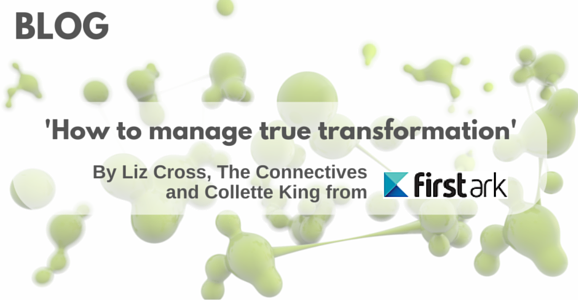Collette King transformation director at First Ark, an innovative social business employing over 600 people in the North West, worked with transformation experts, The Connectives, in a three year, £4.5m transformation programme that has been critical to the organisation’s sustainability, effectiveness and efficiency.
With the blended wisdom of true partnership, they offer their top transformation management advice:
Call things what they really are: Transformation is a word bandied around a lot, and often is used to describe a number of change initiatives led by different directors where there is little collective sign off, control or consideration of interdependencies. Real transformation requires all the pieces of the jigsaw to be available and seen and potentially joined up or left out to make a better picture.
Leadership and independence: In our experience, real organisational transformation is most likely to occur when there is active sponsorship by the CEO, a focused and influential internal transformation director with broad organisational insight and an independent partner with plenty of experience of transformation in many sectors and contexts, which can help create a tailor-made approach using some proven techniques. Together they can drive clarity around what needs to change and why, what the unique opportunities are to leverage change and reduce potential resistance.
Vision led with known and agreed drivers for change: For transformation to work, change must be driven by a clear vision and a thorough understanding of what success would look like if you made that vision real. Your drivers may include improving efficiency or reducing costs; positioning the business for growth; utilising your people better or improving your customer experience; or pursing social value – what’s key is knowing what is driving your change.
These two ‘anchors’ (vision and measures of success) put the needed context to changes required in your structure, the processes used, what capacity and capability you need and leadership behaviours. These are all aspects of an organisation that help or hinder the translation of vision into success, so you must understand how each contributes or frustrates performance and the relationship between them before you make change
Know your current state and gather real evidence: Take a rigorous and real look at your organisation, gather baseline data and test how transforming your business would better meet your drivers. Unless you really understand the ‘current state’ – how you deliver your business today – any attempt to build a future model and a map to get you there will be flawed.
Leave egos at the door: Create the discipline of a programme office and programme governance, and get buy-in. During a transformation, so much change can happen in pockets and silos, without regard for consequences on other parts of business, and the only way to get to grip on this is to have a proper programme office. Ensure senior people are disciplined in getting sign off and permission to instigate change and remember, even if it is just a temporary change or disposable solution, it still takes time and resource.
Be emotionally intelligent – its people that make things happen: Develop leadership maturity; overseeing transformation is like conducting an orchestra, you must know when to hold on and when to let go, when to engage and when to let others engage.
Asking people to let go of what they’ve always done in order to something differently, or maybe even having different people doing it, requires leaders to really think about the human impact of change on the people they are reliant upon to deliver their services. If you don’t manage this well, don’t be surprised if performance dips considerably.
Influencers come in all kinds of guises: Find advocates to galvanise the bigger group and remember that change agents aren’t always in obvious positions. Don’t overlook people who can influence others just because they aren’t in senior or obvious roles; the cleaners talk to the people working late – don’t under engage parts of the workforce!
Be resilient and flexible: Finally, know when to redirect your efforts; when you hit a brick wall check around the corner for another way, even if you leave it till another day.


